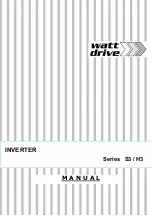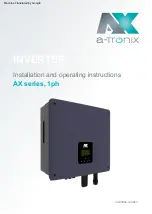
Chapter 2
Installation and Wiring
2-2
2.1.1 Precautions for installation
(1) Transportation
The inverter uses plastic parts. When carrying the inverter, handle it carefully to prevent damage to the parts.
Do not carry the inverter by holding the front or terminal block cover. Doing so may cause the inverter to fall.
Do not install and operate the inverter if it is damaged or its parts are missing.
(2) Surface on which to install the inverter
The inverter will reach a high temperature (up to about 150°C) during operation. Install the inverter on a vertical
wall surface made of nonflammable material (e.g., metal) to avoid the risk of fire.
Leave sufficient space around the inverter. In particular, keep sufficient distance between the inverter and other heat
sources (e.g., braking resistors and reactors) if they are installed in the vicinity.
(3) Ambient temperature
Avoid installing the inverter in a place where the ambient temperature goes above or below the allowable range
(-10°C to +50°C), as defined by the standard inverter specification.
Measure the temperature in a position about 5 cm distant from the bottom-center point of the inverter, and check
that the measured temperature is within the allowable range.
Operating the inverter at a temperature outside this range will shorten the inverter life (especially the capacitor life).
(4) Humidity
Avoid installing the inverter in a place where the relative humidity goes above or below the allowable range (20% to
90% RH), as defined by the standard inverter specification.
Avoid a place where the inverter is subject to condensation.
Condensation inside the inverter will result in short circuits and malfunctioning of electronic parts. Also avoid places
where the inverter is exposed to direct sunlight.
(5) Ambient air
Avoid installing the inverter in a place where the inverter is subject to dust, corrosive gases, combustible gases,
flammable gases, grinding fluid mist, or salt water.
Foreign particles or dust entering the inverter will cause it to fail. If you use the inverter in a considerably dusty
environment, install the inverter inside a totally enclosed panel.
5 cm or more
5 cm or more
(*1)
(*2)
Inverter
Keep enough clearance between the
inverter and the wiring ducts located
above and below the inverter to prevent
the latter from obstructing the
ventilation of the inverter.
(*1) 10 cm or more : up to 55kW
30cm or more : 75kW or more
(*2) 10 cm or more : up to 55kW
30cm or more : 75kW or more
But for exchanging the DC bus capacitor,
take a distance.
22cm or more : up to 55kW
30cm or more : 75kW or more
In
ve
rt
er
Air flow
Wall
Summary of Contents for SJ700D-004L
Page 16: ...Contents Appendix Appendix A 1 Index Index Index 1 ...
Page 44: ...Chapter 2 Installation and Wiring 2 23 Memo ...
Page 70: ...Chapter 3 Operation 3 25 Memo ...
Page 248: ...Chapter 5 Error Codes 5 11 Memo ...
Page 256: ...Chapter6 Maintenance and Inspection 6 7 Memo ...
















































